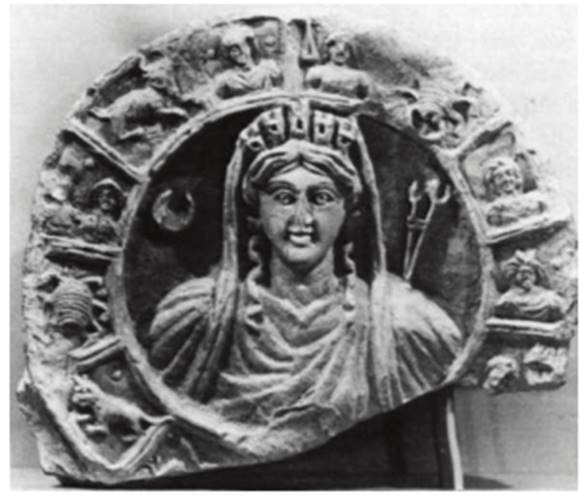Relief with bust of Atargatis/ Tyche in the zodiac. Khirbet Tannur, Jordan, lst-2nd century. Limestone
Well preserved but for a broken nose, this limestone relief originally included the figure of a winged Nike, now located in Amman (Glueck, 1965, pi. 47), which held it up with the rest of the missing zodiacal ring. Once part of the sacred sculpture adorning a Nabataean temple to Hadad and Atargatis, the female bust represents Atargatis, consort of the sky god, Hadad, and mistress of fertility, maternity, and love—a patroness of wellbeing. Her representation with the mural crown, derived from the Greek Tyche and symbolic of her guardianship of a city, indicates the deity's role as a protector of the Nabataeans and, by virtue of her celestial attributes, the very dimensions of her power.

The frontal bust projects an image of ritual force after the pattern of Atargatis representations known in the Near East. The crescent moon over her right shoulder relates her to Selene, the moon goddess, while the wandlike attribute that ends in a crescent and torch or ear of grain over the left shoulder serves as a traditional standard of Atargatis, possibly a mixed sign of astral power and of fertility. Of especial interest is the zodiac ring, which frames the bust in a tondo (imago clipeata), a familiar form in classical art, where it is used as a device of exaltation.
Here, the frame has been transformed into a celestial ring (clipeus caelestis) by the individualized signs of the zodiac, read in two sections that are divided directly over the head of the goddess. On the left: Aries (bust with ram), Taurus, Gemini, Cancer, Leo, Virgo (together with Amman fragment, bust with wheat stalk); on the right: Libra (bust with scales), Scorpio, Sagittarius (youth with spear), Capricorn (horned bust), Aquarius (bust with water vessel), Pisces (missing here, but preserved in Amman).
Stahlman believes that the ring presents schematically the positions of various planets and constellations on 23 March a.d. 5 (Cincinnati, 1970, p. 62). This calculation has been used to date the sculpture rather than to identify some celestial event charged with cult significance, possibly the equinox. The relief should be given a later date, probably in the second century, although precise criteria have not been established for the stylistic evolution of Nabataean art.
The Atargatis relief exhibits certain formal properties—frontality, deep, even crude cutting, sharp contrasts of light and dark, and the piling up of attributes—together with an evident mixture of classical and indigenous motifs which are also found in works of hybrid sculpture from Roman Syria, the Hauran, Dura Europos, Palmyra, and Coptic Egypt. The wavering assimilation of classical forms and images into an indigenous artistic mode in the service of ritual is a common phenomenon in the Eastern provinces of the late Roman Empire. The celestial pretensions of Atargatis were not exclusive, while the image of this deity as patroness of all good things for mankind eventually matured into the great figure of Maria, Regina Caeli. Bibliography: Essen, 1963, no. 18; Glueck, 1965, pp. 284, 396, 398-448, pis. 46, 47; Cincinnati, 1970, p. 62.
Date added: 2025-08-31; views: 81;
